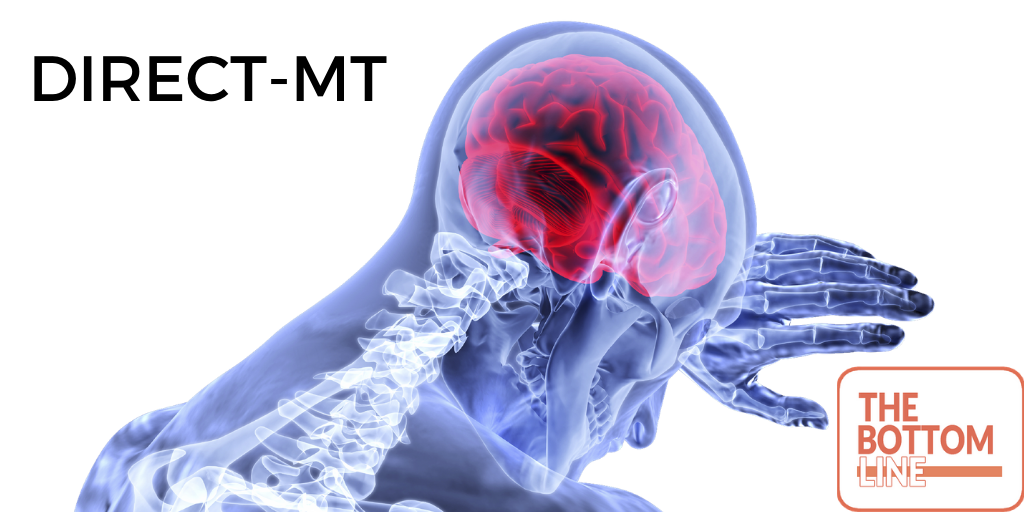DIRECT-MT

DIRECT-MT
Endovascular Thrombectomy with or without Intravenous Alteplase in Acute Stroke
Yang. N Engl J Med 2020; 382:1981-1993. DOI: 10.1056/NEJMoa2001123
Clinical Question
- In patients with acute anterior ischaemic stroke, is endovascular thrombectomy alone, compared with endovascular thrombectomy preceded by intravenous alteplase, noninferior with respect to modified Rankin score at 90 days?
Background
- Prior studies have established the role of endovascular thrombectomy in the treatment of eligible patients with acute ischaemic stroke (MR CLEAN, EXTEND 1A, ESCAPE, SWIFT-PRIME, REVASCAT)
- The role of alteplase before and during thrombectomy in patients with ischaemic stroke is unclear
- It may improve reperfusion potential and dissolve distal thrombi but may make proximal thrombi more difficult to retrieve with thrombectomy
- It may increase cerebral haemorrhagic risks
Design
- Investigator-initiated, multicentre, prospective, randomised, open-label trial with blinded outcome assessment
- Direct Intraarterial Thrombectomy in Order to Revascularise Acute Ischaemic Stroke Patients with Large Vessel Occlusion Efficiently in Chinese Tertiary Hospitals: a Multicentre Randomised Clinical Trial (DIRECT-MT)
- Funded by the National Health Commission of China and the Wu Jieping Medical Foundation
- No involvement in trial design, conduct, protocol review, manuscript preparation, or decision to submit the manuscript for publication
- 1:1 randomisation with the use of a Web-based system, with stratification according to participating site
- The treatment-group assignment was known to both the treating physician and the patient
- Estimated that a sample size of 636 would provide the trial with 80% power (at a two-sided alpha level of 0.05) to determine a noninferiority margin of 0.8, assuming a common odds ratio for scores on the modified Rankin scale (mRS) of 1.16
- This effect would correspond to a difference of 4% between the patients in the thrombectomy-alone group in DIRECT-MT who had a mRS score in the 0-to-2 range, and the intervention group in the MR CLEAN (Multicenter Randomized Clinical Trial of Endovascular Treatment for Acute Ischaemic Stroke in the Netherlands) trial
- Assumption of 5% withdrawal and a conservative 15% reduction in the sample size because of adjustment for major prognostic variables that included age, baseline stroke severity (according to the NIHSS score), the modified Rankin scale score before stroke onset, cerebral collateral blood-flow status, and the time from stroke onset to randomisation
- A total of 20 additional patients were enrolled in order to compensate for those who had major protocol violations
Setting
- 41 academic tertiary care centres in 18 provinces in China
- Selected on the basis of their stroke treatment capabilities as recorded in a national prospective database of Chinese stroke centre
- Required to have performed at least 30 endovascular thrombectomy procedures during the previous year
- Study conducted from February 23, 2018, through July 2, 2019
Population
- Inclusion
- A clinical diagnosis of acute ischaemic stroke
- Occlusion of the intracranial segment of the internal carotid artery (both terminus and nonterminus occlusions) and/or of the first or proximal second segment of the middle cerebral artery confirmed by CTA
- CT or MRI ruling out intracranial haemorrhage
- Eligible for IVT and MT (within 4.5 hours after symptom onset)
- NIHSS ≥ 2
- Age of 18 years or older
- Written informed consent
- Information about the extent of early cerebral ischaemia on baseline computed tomography (CT) as measured by the Alberta Stroke Program Early Computed Tomography Score (ASPECTS; range, 0 to 10, with higher scores indicating fewer early ischaemic changes) was not required
- Exclusion
- Disability before the stroke defined as a score of more than 2 on the modified Rankin scale (range, 0 [normal] to 6 [death])
- Assessed by the treating physician with the use of information obtained from patients (if possible) or their family members
- Any contraindication for IVT, according to guidelines of the American Heart Association (AHA)–American Stroke Association (ASA)
- Blood pressure > 185/110 mmHg
- Blood glucose < 2.7 or > 22.2 mmol/L
- Cerebral infarction in the previous 6 weeks with residual neurological deficit or signs of recent infarction on neuro-imaging
- Serious head trauma in the previous 3 months
- Major surgery or serious trauma in the previous 2 weeks
- Gastrointestinal or urinary tract haemorrhage in the previous 3 weeks
- Previous intracerebral haemorrhage
- Use of anticoagulant with INR exceeding 1.7
- Known thrombocyte count less than 100 × 109/L
- Treatment with direct thrombin or factor X inhibitors
- Treatment with heparin (APTT exceeds the upper limit of normal value) in the previous 48 hours
- Disability before the stroke defined as a score of more than 2 on the modified Rankin scale (range, 0 [normal] to 6 [death])
- Baseline characteristics of thrombectomy alone (n=327) vs combination-therapy group (n=329)
- Median age 69 years
- 56.4% male
- Median NIHSS score 17
- Median ASPECTS value 9
- Median time from stroke onset to randomisation
- 167 minutes vs. 177 minutes
- Median time from randomisation to groin puncture
- 31 minutes vs. 36 minutes
Intervention
- Endovascular thrombectomy alone (n=326)
Control
- Thrombolysis + thrombectomy (n=328)
- Combined treatment with intravenous alteplase (at a dose of 0.9 mg per kilogram of body weight) before endovascular thrombectomy
- The alteplase infusion could be completed during endovascular thrombectomy, even if the procedure was successful in establishing revascularisation
Management common to both groups
- Clinical assessments were performed at baseline, at 24 hours after randomisation, at 5 to 7 days or at the time of hospital discharge (whichever came first), and at 90 days (within a window of ±14 days)
Outcome
- Primary outcome
- Modified Rankin scale score assessed at 90 day – thrombectomy alone was non-inferior to combination thrombectomy with IV alteplase treatment
- Adjusted common OR 1.07, 95% C.I. 0.81-1.40; p=0.04
- Unadjusted common OR 1.09, 95% C.I. 0.84-1.43; p=0.02
- Modified Rankin scale score assessed at 90 day – thrombectomy alone was non-inferior to combination thrombectomy with IV alteplase treatment
- Secondary outcomes
- Comparing thrombectomy vs. thrombectomy + thrombolysis groups
- No significant differences in:
- Modified Rankin scale score at 90 days according to range
- 0 or 1: 25% vs. 23%, OR 1.09 (95% C.I. 0.74 to 1.59)
- 0 to 2: 37% vs. 37%, OR 0.97 (95% C.I.0.68 to 1.37)
- 0 to 3: 56% vs. 51%, OR 1.25 (95% C.I.0.89 to 1.76)
- 0 to 4: 67% vs. 63%, OR 1.25 (95% C.I.0.88 to 1.77)
- 0 to 5: 82% vs. 81%, OR 1.10 (95% C.I.0.73 to 1.67)
- Median NIHSS score
- After 24 hours: 12 vs. 12
- At 5-7 days or discharge: 8 vs. 8
- Barthel Index of 95 or 100 at 90 days
- 48% vs. 46%
- Recannulisation at 24-72 hours, as assessed on CTA
- 85% vs. 89%, OR 0.71 (95% C.I. 0.42-1.2)
- Median lesion volume on CT
- 36ml vs. 37ml
- Modified Rankin scale score at 90 days according to range
- In thrombectomy + thrombolysis group, significantly greater rates of
- Successful reperfusion before thrombectomy
- 2.4% vs. 7%, OR 0.33 (95% C.I. 0.14-0.74)
- Successful reperfusion before thrombectomy
- No significant differences in:
- Comparing thrombectomy vs. thrombectomy + thrombolysis groups
- Safety outcomes
- Comparing intervention vs. control groups:
- Death
- 18% vs. 19%, RR 0.94 (0.68–1.30), p=0.71
- Asymptomatic intracranial haemorrhage
- 33% vs. 36%, RR 0.92 (0.75–1.14), p=0.45
- Symptomatic intracranial haemorrhage
- 4% vs. 6%, RR 0.70 (0.36–1.37), p=0.30
- Infarction in new territory at 5–7 days
- 3% vs. 3%, RR 1.23 (0.52–2.93), p=0.64
- Large or malignant MCA infarction
- 13% vs. 13%, RR 0.98 (0.66–1.46), p=0.93
- Any procedural complication
- 15% vs. 14%, RR 1.05 (0.72–1.52), p=0.80
- Death
- Comparing intervention vs. control groups:
Authors’ Conclusions
- In patients with acute ischaemic stroke with large-vessel occlusion, endovascular thrombectomy alone was noninferior to thrombectomy preceded by alteplase administered within 4.5 hours after symptom onset, within a relative margin in the confidence interval of 20% in the shift between categories of the modified Rankin scale at 90 days
Strengths
- An independent data and safety monitoring board was responsible for safety, ethics, and conduct oversight with the use of results of interim analyses
- An independent contract research organisation (Cardiovascular Chinese Research Centre) and site management organisation (Shanghai Taisure Medical Technology) were involved in monitoring to ensure trial quality
- Primary outcome was assessed per-protocol
- Patients who met all the eligibility criteria and received the assigned treatment or had recovered or had deterioration in their condition before receiving endovascular treatment
- Allocation concealment with computerised randomisation
- Blinding of the outcome assessors
- Only 1 patient lost per group
Weaknesses
- Authors note that external validity may be impacted by differences in stroke rates between Asian and non-Asian patients
- Trial designed in accordance with the 2015 AHA–ASA guidelines
- Stent retrievers were recommended for thrombectomy and intravenous thrombolysis was restricted to standard doses of alteplase
- Trial did not take into account newer thrombectomy devices such as aspiration catheters and thrombolytic drugs such as tenecteplase (explored in the EXTEND-1A TNK study)
- Prespecified noninferiority margin was generous, the sample was small, and there were wide confidence intervals around the primary outcome results
- Possible that combined-therapy is superior
- Patient consent requirements and payment process in China may have impacted time to alteplase in the combined-treatment group
- Patients in combined treatment group received thrombectomy only a median of 5 minutes later than those in thrombectomy alone group. This means that these results may not apply to centres that give thrombolysis prior to transferring to a tertiary centre for thrombectomy
The Bottom Line
- This is an interesting study which likely applies mainly to stroke centres with thrombectomy capability, but unclear whether the data are robust enough to affect practice, particularly at smaller facilities without thrombectomy capability
External Links
- Yang. Endovascular Thrombectomy with or without Intravenous Alteplase in Acute Stroke
- NNT: Tissue Plasminogen Activator (tPA) For Acute Ischemic Stroke
- NEJM: Mauri. Challenges in the Design and Interpretation of Noninferiority Trials
- REBEL EM: The DIRECT-MT Trial: Are Systemic Lytics Necessary in LVO Treatment?
Metadata
Summary author: Dan Hu, PharmD, BCCCP
Summary date: 5/24/20
Peer-review editor:@celiabradford




Excellent article on Endovascular Thrombectomy I would like to thank you for the efforts you have made in writing this article.